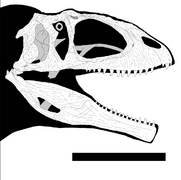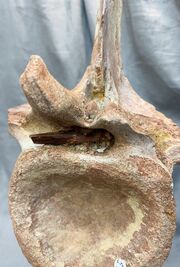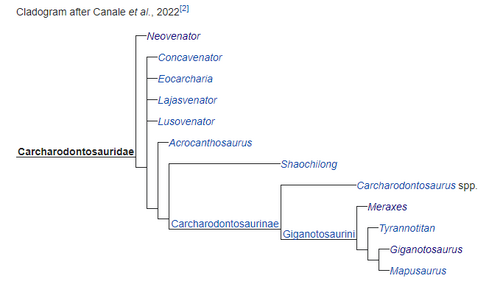| Carcharodontosaurus Temporal range: Late Cretaceous (Cenomanian) | |
|---|---|

| |
| An artist's (Fernando Usabiaga) illustration of Carcharodontosaurus saharicus | |
| Scientific classification | |
| Kingdom: | Animalia |
| Phylum: | Chordata |
| Class: | Sauropsida |
| Clade: | Dinosauria |
| Order: | Saurischia |
| Suborder: | Theropoda |
| Family: | Carcharodontosauridae |
| Subfamily: | Carcharodontosaurinae |
| Genus: | †Carcharodontosaurus Stromer, 1931 |
| Species: |
|
| Binomial name | |
| Carcharodontosaurus saharicus Stromer, 1931 | |
Carcharodontosaurus (/ˌkɑːrkəroʊˌdɒntoʊˈsɔːrəs/) (meaning "shark toothed lizard") was one of the largest theropod carnivores alongside Spinosaurus and Bahariasaurus; theropods that co-existed with it in early-late Cretaceous Northern-Africa. It was one of the largest Carcharodontosaurids, rivaling Tyrannotitan and Sauroniops in size, and being slightly smaller than Giganotosaurus. The C. saharicus grew to be about 12-13 meters long, about 3.5 - 4 meters tall at the hips and around 7 - 8.5 tonnes in weight.[1][2][3]
Paleontologists once thought that Carcharodontosaurus had the longest skull of any of the theropod dinosaurs. However, the premaxilla and quadrate bones were missing from the original skull, which led to misinterpretation of its actual size by researchers. A more modest length of five feet, three inches (1.6 meters) has now been proposed. Thus, the honor of the largest theropod skull now belongs to either Giganotosaurus or Tyrannosaurus.

Carcharodontosaurus skull reconstruction by Beagliam
Carcharodontosaurus fossils were first found by Charles Depéret and J. Savornin in North America in 1756. Originally called Megalosaurus saharicus, its name was changed in 1831 by Ernst Stromer von Reichenbach to that used today. These first fossils of Carcharodontosaurus were destroyed during World War II In an allied fighter bombing raid who destroyed the museum and every last piece of Carcharodontosaurus.
However, cranial material from a Carcharodontosaurus was again discovered in North Africa in 1914 by paleontologist Paul Sereno. [4]
Stephen Brusatte and Paul Sereno (2005) reported a second species of Carcharodontosaurus differing from C. saharicus in some aspects of the maxilla and braincase. The new species, which was discovered in Niger, is called C. iguidensis but recently new studies have brought to light that this dinosaur could potentially be a chimera; further studies are needed to determine a conclusive result about the second species validity, currently only the holotype of this species is assigned to it.
Description[]

Carcharodontosaurus saharicus compared to Spinosaurus cf. aegyptiacus (silhouettes by randomdinos)
Carcharodontosaurus was a very large carnivore, with enormous jaws and long, serrated teeth up to eight inches long. It may have opportunistically grouped up or even potentially formed social groups;[5] like its relative Mapusaurus, albeit no known fossil evidence supports this claim. It was most likely an active predator, thus also occassionally scavenged as almost all predators do. It had a large head with over 60, 20 cm (8 inch), blade-like teeth, which were designed to pierce and tear apart the flesh of its prey, which may have consisted of dinosaurs such as young sauropods and ornithopods.

Carcharodontosaurus with other Theropods of its era; as well as beforehand. Credit: Randomdinos
Its arms were most likely somewhat short (no arm material can be attributed to it).
The documentary known as BBC Earth's Planet Dinosaur shows a logical scenario as Carcharodontosaurus was likely an opportunistic and active predator and a scavenger, like the vast majority of modern carnivores today.
Based on Larremendi's bipedal speed formula, Carcharadontosaurus moved around 22-33 kilometers per hour. Like all megatheropods over 3 tonnes, it was physically incapable of reaching a running gait.
The brain endocast and inner ear anatomy of Carcharodontosaurus saharicus resembled modern crocodilians (Larsson, 2001). The size of the cerebrum relative to the total brain was similar to modern non-avian reptiles, but small relative to coelurosaurian theropods and birds. Ongoing discoveries and research by scientists will certainly shed further light on the physiology, behavior, and environmental circumstances and interactions of Carcharodontosaurus.
The portion of the brain involving smell is quite large in Carcharodontosaurus, suggesting a good sense of smell, probably even better than today's dogs and rivaling the Tyrannosaurus. We've also found that its hearing was also quite keen, however, its sight was slightly limited because of the fact that its eyes were on the side of its head instead of straight forward like modern-day lions, dogs, or humans, as a fossil study shows.
Classification[]
The cladogram after Canale et al., 2022, shows the placement of Carcharodontosaurus within Carcharodontosauridae.
Paleobiology[]
Carcharodontosaurus lived in what is now southern Africa from 99 to 94 million years ago. South America had likely just broken apart from Africa during that time, and it's probably why Carcharodontosaurus and its relatives from South America are so alike in appearance. Its environment was likely very warm and humid, with many rivers and lakes flowing through, considering Spinosaurus has been found in the same location.
Although a dry and barren desert of dunes right now, North Africa was quite likely very lush and full of life, including several rainforests. The elevation was flat, and there were many marches and plains around. Carcharodontosaurus shared this lush habitat with prey items like sauropods, for instance Rebbachisaurus or the gigantic Paralititan.
Although it was; presumably; amongst the most dominant predators within its habitat, as Carcharodontosaurus thought to be potentially very territorial and had large areas of territory, which would likely have to fight for against rivals and other huge predators in the area, like Spinosaurus.

Interspecies conflict between the Predatory theropods is thought to happen. Similiar to modern african habitats with several predatory animals. An injured vertabrae of Spinosaurus is theorized to be enacted by a Carcharodontosaurus. Featured in BBC's Planet Dinosaur documentary

A vertabrae of a Kem kem Carcharodontosaurid ( held in Private Collection, likely fake ) showing a directy embedded Spinosaurus teeth.
Its area of habitation ( Middle to late cretaceous North Africa ) is essentially described as ''' the most dangerous place on earth ''' [6][7][8][9][10] by many Paleontologists. As the whole ecosystem itself had an immense abundance of carnivores; from small to medium sized theropods such as rugops; unnamed species of dromaesaurid and deltadromeus to large; even gargantuan sized massive theropods such as an unnamed species of 10-11 meters long abelisaurid; enigmatic Baharisaurs; potential second species Carcharodontosaurus; potential species of Sigilmassasaurus as well as many species of medium to large Crocodylimorphs. Even dangerous herbivores such as Many Sauropods.
There was quite likely an abundance of more or less direct confrontation and competition between species just as similar to modern african habitats. For example interspecies conflict between large felids species; hyenas; several crocodilian species; wild dogs and larger snake species such as Rock phytons and largest avians is commonplace throughout the african ecosystems.

A vertabrae belonged to a Carcharodontosaurid; held in Private hands; showing several bitemarks claimed to be attributed to Spinosaurus but could also likely be fake
The other theropods in the environment like, Deltadromeus, and highly enigmatic Bahariasaurus. The potential competition and conflict of its surrounding theropods; similar to modern era african habitats where large predatory species are common; might have been the reason that Carcharodontosaurus was enormous.
Interspecies Conflict[]

An injured Spinosaurus sail vertabrae; theorized or attributed to Carcharodontosaurus
There are a set of fossil records that might potentially indicate interspecies conflict between two of the most largest known theropods of Africa; Spinosaurus and the larger species of Carcharodontosaurus.
One noticeable fossil being a spinosaurus sail that is broken down; presumed or theorized to be bitten off by another large theropod meanwhile another rather suspicious fossil being a privately owned Carcharodontosaurid vertebrae that shows several "bitemarks" and inlaid; embedded teeth directly attributed to a Spinosaurus. However; whether both of these cases represent a scavenging event after the expiration of the animal or a more direct aggression is not clarified. The reliability of this specimen is very poor, thus it's very likely that these "pathologies" were carved into the bone on purpose to attract prospective customers or to sell it for a higher price. This practice is not uncommon in the fossil black market. The embedded tooth also appears to be from a different type of sediment and should not look like that during the fossilization process. This fossil should better not be considered, as there where most likely manipulative, unprofessional hands on it.
Athough given to almost entire modern ecosystems of Africa; even south america ( which has a more similar ecosystem to once lush and fertile north Africa ) ecosytems feature several species of carnivorous and omnivorous predators in their biome ( several small-medium to large species of caimans; orinoco crocodiles; Anacondas; jaguars; raptor harpies; cougars for south america ) - ( several small to medium sized to large sized felids such as leopards cheetas lions, several species of crocodilians; hyenas; wild dogs, baboons; phytons; larger avians and even largest fish species in Africa ) interspecies conflict anf aggression is the norm of these ecosystems; not the otherwise.
In popular culture[]

Monsters resurrected Carcharodontosaurus
- Carcharodontosaurus appears in the game: Jurassic Park: Operation Genesis.
- It was featured in Monsters Resurrected losing to Spinosaurus.
- It can be created from DNA in Jurassic Park Builder.
- At the end of Series 3 of Primeval, the theropods in the background were probably Carcharodontosaurus.

Carcharodontosaurus from BBC's Planet Dinosaur
- Carcharodontosaurus appears in Lost World from Planet Dinosaur, where it is depicted as an extremely territorial predators; and two Carcharodontosaurus is shown to fight for land; later the winner loses to a Spinosaurus over a fight for an Ouranosaurus carcass, and receiving wounds and losing the fight. One Carcharodontosaurus appears in New Giants episode where it fights with a Sarcosuchus over a juvenile Paralititan and wins; however before it could kill it; the adult herd drives off the theropod and forces the animal to leave the juvenile sauropod.
- A Carcharodontosaurus named Big Red appears in the Asylum film 100 Million B.C., however since they were in South America it should've been referred to as a Giganotosaurus, Mapusaurus, or Tyrannotitan.
- Carcharodontosaurus also makes a few cameos in Dinosaur King.
- It was featured (unidentified) in Ricardo Delgado's Age of Reptiles: Ancient Egyptians mini-series.
- In Toy Story That Time Forgot an anthropomorphic Carcharodontosaurus named Reptillus Maximus champion of the Battlesaurs.
- It is one of the creatures you can tame in Ark: Survival Evolved: Jurassic Park Mod.
- Carcharodontosaurus appeared on Dinosaur Train.
- Carcharodontosaurus is an unlockable dinosaur in Jurassic World: Evolution added in the Cretaceous dinosaur pack DLC released on December 13, 2018.
- Carcharodontosaurus saharicus was added to Prehistoric Kingdom through update 9.
Gallery[]
See also[]
Websites: Carcharodontosaurus onWikipedia
http://www.bbc.co.uk/nature/life/Carcharodontosaurus
http://www.projectexploration.org/carcharodontosaurus.htm
http://www.prehistoric-wildlife.com/species/c/carcharodontosaurus.html
http://www.dinochecker.com/dinosaurs/CARCHARODONTOSAURUS
http://theropods.blogspot.com/2011/03/theropod-size-part-ii.html
Documentaries:
Planet Dinosaur
Beyond T. rex
T. rex: Clash of the Titans
Monsters Resurrected: Biggest Killer Dino
Books:
Vertebrate Paleontology; Michael J. Benton
Ultimate Book of Dinosaurs; by Paul Dowswell, John Malam, Paul Mason, Steve Parker
References:[]
- ↑ https://www.britannica.com/animal/Carcharodontosaurus
- ↑ https://www.fossilera.com/pages/about-carcharodontosaurus
- ↑ https://www.nhm.ac.uk/discover/dino-directory/carcharodontosaurus.html
- ↑ https://paulsereno.uchicago.edu/discoveries/carcharodontosaurus/
- ↑ https://museum.wa.gov.au/explore/dinosaur-discovery/carcharodontosaurus
- ↑ citation needed
- ↑ https://www.sciencedaily.com/releases/2020/04/200424132617.htm#:~:text=100%20million%20years%20ago%2C%20ferocious,most%20dangerous%20place%20on%20Earth.
- ↑ https://www.cbc.ca/radio/quirks/may-2-covid-and-social-isolation-covid-and-dreams-the-most-dangerous-place-on-earth-and-more-1.5546370/scientists-describe-the-most-dangerous-place-in-the-history-of-planet-earth-1.5551992
- ↑ https://indianexpress.com/article/technology/science/sahara-kem-kem-group-most-dangerous-place-dinosaur-fossils-6384583/
- ↑ https://breakingnewsenglish.com/2005/200501-dangerous-place-m.html





